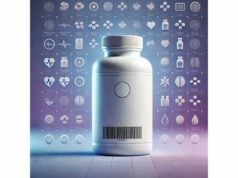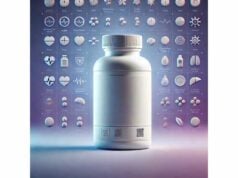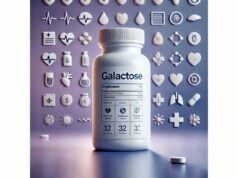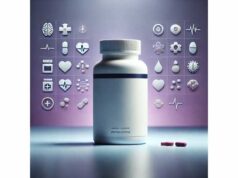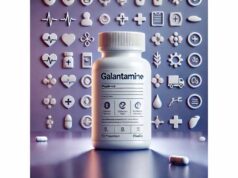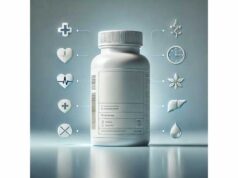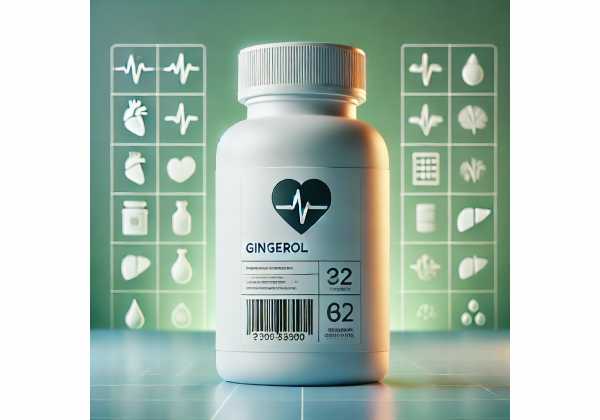
Gingerol is the signature pungent compound in fresh ginger that gives the root its heat—and much of its therapeutic reputation. As a bioactive phenolic, gingerol contributes to ginger’s well-known effects on nausea, digestion, and inflammation. Research shows that 6-gingerol (the most abundant form) interacts with serotonin signaling in the gut, influences inflammatory pathways, and is rapidly metabolized and cleared by the body. For everyday use, most people encounter gingerol not as a purified ingredient but within standardized ginger extracts, teas, and foods. This guide explains what gingerol is, how it may help, how to use ginger-rich preparations wisely, and what to watch for if you take medications or have certain conditions. You will also find practical dosing ranges drawn from human studies, sensible safety guardrails, and a brief look at the evolving evidence so you can make informed, people-first decisions.
Quick Overview
- May reduce pregnancy-related nausea and support normal digestion.
- Shows anti-inflammatory activity and may modestly ease certain pain symptoms.
- Typical trial dose: 1,000 mg/day dried ginger extract (often ~5% total gingerols).
- Mild heartburn or GI upset can occur; start low and take with food.
- Avoid or get medical advice if you use anticoagulants, have gallstones, or are nearing surgery.
Table of Contents
- What is gingerol and how it works
- Evidence-backed benefits people ask about
- How to use gingerol: forms and dosing
- Who should avoid or be careful
- Interactions, quality, and sourcing
- What the science says so far
What is gingerol and how it works
Gingerol is a family of phenolic compounds found in the rhizome of Zingiber officinale (ginger). The members are named by carbon chain length—most notably 6-gingerol, 8-gingerol, and 10-gingerol—with 6-gingerol the predominant form in fresh ginger. When ginger is dried or heated, some gingerols dehydrate into shogaols (for example, 6-shogaol), which are generally more pungent. Together, gingerols and shogaols are considered the primary pungent bioactives responsible for many of ginger’s observed effects.
Chemical nature and kinetics. Gingerols are lipophilic phenolics with a vanillyl group that interacts with cellular targets. After oral intake, free (unconjugated) gingerols are rarely detected in human plasma. Instead, they appear as glucuronide and sulfate conjugates and are cleared relatively quickly. Peak blood levels typically occur within ~30–120 minutes, and half-lives are commonly under 3 hours. In longer supplementation courses, metabolites such as gingerdiols can accumulate modestly, reflecting ongoing metabolism and enterohepatic handling. Because of this rapid conversion, consistent daily intake—rather than occasional large doses—better aligns with how the body processes gingerol.
How gingerol may work. Several mechanisms help explain the traditional uses:
- Antiemetic pathways. Gingerol-rich extracts can interact with the serotonin (5-HT) system in the gastrointestinal tract, including modulation of 5-HT3 signaling in gut vagal afferents. This aligns with reports of reduced nausea in settings like early pregnancy and motion sensitivity.
- Pro-motility effects. In functional GI disturbances, ginger compounds may support normal gastric emptying and reduce dysrhythmic gastric slow waves—mechanisms that can translate into less queasiness or fullness.
- Anti-inflammatory actions. Gingerol influences key inflammatory nodes such as NF-κB, COX-2, and 5-lipoxygenase. In vitro and animal work shows reduced expression of pro-inflammatory cytokines and mediators, with emerging clinical signals for symptom relief in some conditions.
- Ion channel and neuronal effects. Gingerols can interact with TRP channels (notably TRPV1), which are involved in nociception and visceral sensation. This may partially explain benefits for discomfort and the characteristic warming feel.
- Antioxidant support. As phenolics, gingerols can scavenge reactive species and upregulate endogenous defenses—supportive rather than decisive effects, but relevant for redox balance in inflamed tissues.
Gingerol vs. ginger essential oil. Essential oil is dominated by terpenes (e.g., zingiberene, β-bisabolene). Gingerol is not a major constituent of essential oil because it is nonvolatile and heat-labile. If you are seeking gingerol-related effects, choose standardized ginger extracts, powders, or food forms—essential oil is better thought of as an aromatic.
Fresh vs. dried. Fresh ginger is gingerol-rich; drying or prolonged heat shifts some gingerol to shogaol. Both classes are bioactive but differ in potency and sensory profile. People who find fresh ginger too sharp sometimes tolerate the warmer profile of dried forms; others do the reverse.
Taken together, gingerol is best understood as one member of a small team (with shogaols and related metabolites) that act quickly after ingestion, are rapidly conjugated, and influence gut-brain signaling and inflammatory pathways in ways that match ginger’s traditional uses.
Evidence-backed benefits people ask about
Pregnancy-related nausea (NVP). Among all uses, the most consistent human data concern nausea and vomiting in early pregnancy. Across multiple randomized trials and meta-analyses, ginger supplementation (often 1,000 mg/day of dried ginger powder or equivalent extract for short periods) reduces nausea intensity and, in many studies, decreases vomiting episodes versus placebo. Some trials show equivalence to standard options such as vitamin B6 for symptom improvement. While heterogeneity exists (different formulations, dosing schedules, and outcome scales), pooled estimates typically favor ginger. Importantly, safety signals in these analyses have been reassuring when doses stay near trial ranges and durations are short (often several days to a few weeks). Because products vary, discuss use with a prenatal clinician—especially if symptoms are severe or dehydration is present.
General nausea and motion-related queasiness. Outside pregnancy, ginger has been studied for post-operative nausea, motion sickness, and chemotherapy-related nausea. Findings are mixed but trend toward modest benefit, particularly for nausea intensity. Given gingerol’s effects on serotonergic and pro-motility pathways, individuals prone to queasiness often trial ginger capsules, chews, or teas before travel or procedures. For motion sickness, earlier intervention (30–60 minutes before exposure) appears more helpful than rescue dosing.
Functional digestive comfort. Ginger’s traditional role as a carminative has biological plausibility. Modest improvements in bloating, early satiety, or slow gastric emptying have been reported in select studies, although endpoints vary and not all trials are positive. In practice, people with occasional dyspepsia may find ginger tea or standardized capsules taken with meals help settle the stomach—especially when combined with gentle dietary measures (smaller meals, reduced high-fat triggers).
Pain and inflammation. Ginger extracts that contain both gingerols and shogaols have shown small, clinically meaningful effects on symptoms in osteoarthritis and exercise-induced muscle soreness in some trials. These benefits likely reflect multi-target modulation (COX-2, 5-LOX, cytokines) rather than single-pathway inhibition. Effects build over days to weeks and are modest compared with prescription anti-inflammatories, but side-effect profiles are often gentler. People seeking incremental relief sometimes stack ginger with physical therapy, weight management, or topical measures.
Metabolic markers. Early clinical work suggests ginger supplementation can produce small improvements in fasting glucose or lipids in certain populations. These signals are promising but not definitive, and heterogeneity in study design limits firm conclusions. If you live with diabetes, treat ginger as supportive at best—not as a replacement for lifestyle change or prescribed medication—and monitor glucose closely when adding any supplement that might affect glycemia.
Immunity and respiratory comfort. Preclinical data show gingerol-rich compounds modulate immune cell signaling and might influence airway smooth muscle tone. Small pilot studies are exploring these areas, but evidence is preliminary. For now, using ginger as a soothing beverage when you have a cold is reasonable; expecting strong disease-modifying effects is not.
What to expect. Gingerol’s actions are fast, but human effects are subtle and context-dependent. For nausea, benefits may appear within hours to a day; for pain or inflammation, give 2–8 weeks before judging. Most people who respond report symptom “softening” rather than complete resolution.
How to use gingerol: forms and dosing
Know what you are taking. Labels may list “ginger root,” “ginger extract,” or “standardized to X% total gingerols.” Because isolated 6-gingerol supplements are uncommon, most users take ginger extracts that deliver gingerol plus companion compounds like shogaols. For gingerol-related benefits (nausea, digestive comfort), look for standardized extracts near 5% total gingerols; this mirrors formulations used in human pharmacokinetic and clinical studies.
Common forms and practical choices
- Standardized capsules/tablets. Convenient, consistent dose. Choose products with clear standardization (e.g., “5–6% total gingerols”) and lot testing for heavy metals and microbial quality.
- Powdered ginger. Culinary spice can be used functionally. For consistent dosing, measure with a ¼ teaspoon spoon (~500–600 mg for many kitchen grinds, though weights vary by brand and grind).
- Teas and chews. Gentle, good for sip-by-sip nausea relief. Extract strength varies; use as adjuncts.
- Fresh ginger. Excellent for culinary use. Grate or slice into meals or hot water; gingerol content varies with freshness and storage.
Evidence-informed dosing ranges
- Pregnancy-related nausea: A frequently studied range is 1,000 mg/day of dried ginger (often split: 250 mg, 4 times daily) for short courses (days to a few weeks). Stay near this range unless advised otherwise by your prenatal clinician.
- Motion sickness or general nausea: 500–1,000 mg/day, divided, starting 30–60 minutes before the trigger. For travel, some alternate 250–500 mg every 4–6 hours as needed.
- Digestive comfort (dyspepsia, bloating): 250–500 mg with meals, up to 1,000 mg/day, reassessing within 1–2 weeks.
- Inflammatory discomfort (adjunct): 1,000–2,000 mg/day in divided doses for 4–8 weeks, monitoring tolerance.
These amounts refer to dried ginger extract or powder, not purified 6-gingerol. If your product lists total gingerols, a 5%-standardized capsule of 250 mg contains about 12.5 mg of total gingerols. Because free gingerol is rapidly conjugated, steady, divided dosing is more sensible than a single large bolus.
How to start, step-by-step
- Check your meds and conditions (see safety sections).
- Pick a quality product with clear gingerols standardization.
- Begin low: 250 mg with food to test tolerance.
- Titrate every 24–48 hours toward your target (e.g., 250 mg 3–4×/day).
- Track response (nausea score, meals tolerated, or pain scale).
- Reassess at 2 weeks; continue, adjust, or stop based on benefit and side effects.
Timing tips
- For nausea, earlier is better—before triggers or at first hint of symptoms.
- For day-long queasiness, divide the dose across meals and early evening.
- To reduce heartburn, take with food and avoid lying down within 30–60 minutes.
When to stop or change plan
- Worsening reflux, persistent abdominal discomfort, rash, lightheadedness, or unusual bleeding/bruising.
- No benefit after a reasonable trial (e.g., 1–2 weeks for nausea; 4–8 weeks for pain).
- New medications added that interact with coagulation or glucose control.
Who should avoid or be careful
Gingerol-rich preparations are generally well tolerated at common supplemental doses, but some situations call for extra caution or medical guidance.
Situations requiring clinician input
- Anticoagulants and antiplatelets. Gingerol and related compounds can inhibit platelet aggregation in vitro. Clinical bleeding events are uncommon at typical doses, but if you take warfarin, direct oral anticoagulants, high-dose aspirin, clopidogrel, or combination therapy, seek individualized advice and monitor for bruising, nosebleeds, or gum bleeding.
- Upcoming surgery or dental procedures. Because of theoretical bleeding risk, many clinicians advise stopping ginger supplements 1–2 weeks before procedures unless your surgical team says otherwise.
- Gallstones and biliary colic. Ginger may influence bile flow and GI motility. If you have known gallstones or bile duct obstruction, avoid self-experimentation and ask your clinician first.
- Diabetes or reactive hypoglycemia. Some studies report small reductions in fasting glucose; if you use insulin or secretagogues, monitor closely when adding ginger and coordinate with your diabetes care team.
- Pregnancy and lactation. Short-term use around 1,000 mg/day of dried ginger for early pregnancy nausea has supportive safety data. Still, discuss personal risks (e.g., hyperemesis, dehydration, concurrent meds) with your obstetric provider. For lactation, evidence remains limited; err on the side of lower doses and shorter durations unless directed by a clinician.
- History of severe reflux or peptic ulcer. Ginger can aggravate heartburn in some individuals. If reflux is active, start with tea or small doses with food; discontinue if symptoms worsen.
Side effects to watch for
- Gastrointestinal: mild heartburn, abdominal discomfort, gas, diarrhea, or constipation. These typically resolve by lowering the dose or taking with meals.
- Dermatologic: rare rash or hives. Stop and seek care if swelling, wheeze, or throat tightness occur.
- Neurologic: occasional lightheadedness in sensitive individuals—often dose-related.
Medication classes with plausible interactions
- Blood thinners/antiplatelets: potential additive effects on bleeding time.
- Hypoglycemics: potential additive glucose-lowering.
- Blood pressure medications: minimal direct interactions expected, but any new supplement warrants routine BP monitoring if you are titrating meds.
- P-glycoprotein/CYP modulators: at supplemental doses, clinically significant effects are unlikely; nonetheless, monitor when starting ginger alongside narrow-therapeutic-index drugs.
Populations that should avoid self-directed use
- People with a history of unexplained bleeding, active GI ulcers, or recent major surgery.
- Those with diagnosed bile duct obstruction unless cleared by a specialist.
- Individuals with known ginger allergy (rare but possible).
As with any supplement, context matters: dose, duration, co-morbidities, and co-medications. When in doubt, personalize with your clinician—especially if you plan to use ginger daily for more than a few weeks.
Interactions, quality, and sourcing
Interaction themes (practical guidance)
- Bleeding risk: Theoretical risk increases when ginger is combined with anticoagulants or multiple antiplatelet agents. If combination therapy is necessary, keep ginger at conservative doses (e.g., ≤1,000 mg/day), take with food, and monitor for easy bruising, black stools, or prolonged bleeding from cuts.
- Glucose: If you titrate diabetes meds based on home readings, capture a baseline week before ginger, add ginger, and watch for lower-than-usual fasting or pre-meal values. Adjust only with your care team.
- Stomach acid control: If you take proton pump inhibitors or H2 blockers, ginger may still provoke heartburn at higher doses. Consider tea or small capsule doses with meals or skip ginger entirely if reflux flares.
Choose products that match gingerol-focused goals
- Standardization matters. Look for “standardized to total gingerols (e.g., 5–6%).” This connects directly to how research formulations are described. Products that list only “ginger root” without potency details can vary widely.
- Clean labels and testing. Prefer brands that publish third-party testing for identity, potency, heavy metals (lead, arsenic, cadmium, mercury), and microbiology. Certificates of Analysis (CoAs) add transparency.
- Form and extract type. CO₂ extracts and hydroalcoholic extracts can both be effective; what matters most is consistent gingerols content and tolerability for your stomach.
- Essential oil is not a gingerol source. It contains aromatic terpenes, not meaningful gingerol. Use essential oil for scent diffusion if desired, not for gingerol-related health effects.
- Fresh and food forms. Culinary ginger is valuable—gingerol content remains meaningful in fresh root. Grating into soups, stir-fries, or hot water makes practical sense when you prefer food-first strategies.
Label-reading tips
- Serving size vs. per-capsule dose: A “1,000 mg serving” might be two capsules of 500 mg each—check directions.
- Percent standardization: 250 mg at 5% gingerols ≈ 12.5 mg total gingerols per capsule.
- Additives: Minimize unnecessary fillers if you are sensitive; ginger itself can be warming on the stomach.
Storage and shelf life
- Gingerol can degrade with moisture and prolonged heat. Keep capsules tightly sealed in a cool, dry place. For fresh ginger, refrigerate unpeeled rhizomes in a breathable bag or freeze sliced portions to slow flavor loss and dehydration.
Sourcing guidance in real life
- Start with a well-reviewed, third-party tested standardized extract for consistent dosing. Add ginger tea or fresh ginger to meals for comfort and taste. If you tolerate capsules poorly, stick to food-based approaches.
What the science says so far
Pharmacokinetics and metabolism. Human studies show that after oral ingestion of standardized ginger extract (often around 5% total gingerols), free 6-, 8-, and 10-gingerol and 6-shogaol are rarely detected in plasma. Instead, glucuronide and sulfate conjugates predominate, with Tmax commonly under two hours and half-lives typically in the 0.6–2.4 hour range depending on the compound and population studied. Longer supplementation can increase the measurable pool of reduction products (e.g., 6-gingerdiols), indicating dynamic interconversion and potential contributions from metabolites to overall effects. This rapid conjugation explains why divided dosing often outperforms single boluses for steady symptom support.
Clinical outcomes with gingerol-containing preparations. The most robust human signal is for nausea and vomiting in pregnancy, where multiple randomized trials and meta-analyses report reduced nausea intensity and, in several studies, decreased vomiting compared with placebo. In comparisons with vitamin B6, ginger often performs similarly for symptom improvement. Evidence for post-operative or chemotherapy-related nausea is more mixed but trends positive for nausea intensity, particularly when dosing is timed before triggers. For pain and inflammatory conditions, standardized extracts have achieved modest symptom reductions in some osteoarthritis and soreness trials, with wide variability in effect size across studies and products.
Safety profile. Across numerous trials and observational cohorts, ginger is generally well tolerated. Common side effects are mild and gastrointestinal (heartburn, stomach upset). Serious adverse events are rare, and hepatotoxicity has not been convincingly linked to ginger in large safety compilations. Still, product contamination or unlabeled ingredients can confound safety; quality assurance matters. Theoretical bleeding risk arises from antiplatelet activity observed in vitro. In real-world dosing, clinically significant bleeding is uncommon, but caution is prudent with anticoagulants, perioperative periods, and high-dose or multi-agent regimens.
Context and limitations. Many trials are small, use short durations, and differ in extracts, standardization, and outcome measures, which introduces heterogeneity. Publication bias is possible in symptom-based fields. For pregnancy, while outcomes are largely reassuring, study quality varies, and product labeling is inconsistent across global markets. More rigorous, standardized trials using chemically characterized extracts are needed, along with pharmacodynamic work linking conjugated metabolites to clinical effects.
Practical synthesis. For people seeking a low-risk, supportive option for nausea, digestive comfort, or gentle anti-inflammatory support, a standardized ginger extract near 5% total gingerols, taken 250–500 mg per dose with food, and titrated to effect, is a reasonable approach. Expect subtle improvements, reassess within 1–2 weeks (nausea) or 4–8 weeks (pain), and coordinate with your clinician if you take medications that affect coagulation or glucose. For those preferring culinary strategies, fresh ginger and teas are sensible, cost-effective starts.
Bottom line. Gingerol is a fast-acting, rapidly metabolized bioactive with plausible mechanisms and a supportive—though not uniform—clinical evidence base for specific symptom targets, especially nausea in early pregnancy. Use it thoughtfully, choose quality products, and personalize the plan to your health context.
References
- Effectiveness of ginger supplementation in alleviating hyperemesis gravidarum: a systematic review and meta-analysis 2025 (Systematic Review)
- The Use of Ginger Bioactive Compounds in Pregnancy: An Evidence Scan and Umbrella Review of Existing Meta-Analyses 2024 (Umbrella Review)
- Pharmacokinetics of Gingerols, Shogaols, and Their Metabolites in Asthma Patients 2022 (Clinical Pharmacokinetics)
- Pharmacokinetics of 6-, 8-, 10-Gingerols and 6-Shogaol and Conjugate Metabolites in Healthy Human Subjects 2008 (Clinical Pharmacokinetics)
- Ginger – LiverTox – NCBI Bookshelf 2024 (Safety Overview)
Disclaimer
This information is educational and is not a substitute for personalized medical advice, diagnosis, or treatment. Always speak with a qualified healthcare professional before starting, stopping, or combining any supplement—especially if you are pregnant or breastfeeding, preparing for surgery, or taking prescription medications such as anticoagulants, antiplatelets, or diabetes therapies.
If you found this guide useful, please consider sharing it on Facebook, X (formerly Twitter), or your favorite platform, and follow us for future updates. Your support helps us continue creating clear, evidence-informed health content.

